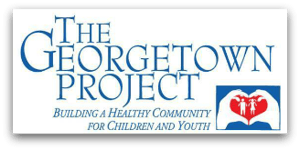Subscribe for Updates

Schools. Afterschool programs. Churches. Mental health services. Mentoring programs. Family-serving organizations. Juvenile justice services. Youth groups. The list goes on.
With so many different groups serving young people in a variety of ways, it can be challenging to implement a shared vision, shared goals, and a shared strategy for youth development in a community.
In a recent interview, Executive Director of The Georgetown Project Leslie Janca discussed how her Texas city of 53,000 people is home to over 30 youth-serving organizations and how they work together to help all young people in the community succeed.
The following are three ways Janca shared about how Georgetown works together to create a community where young people are valued and thrive.
1) Creating a Unified Vision
The Georgetown Project is intentional about how they present the community’s vision for youth development. By aligning all of the work done on behalf of youth in the community with the 40 Developmental Assets®, Georgetown’s various youth organizations are able to communicate with one another using a common language. “The assets have been identified as the framework that our youth development initiatives are planned around. It’s just woven through the fabric of what we do,” Janca explained. “It’s a positive vision for youth that people can rally around.”
To further establish this united vision for the community, The Georgetown Project also publishes a report called a “Snapshot of Georgetown Children & Youth” every few years. The publication brings together a wealth of knowledge about young people in Georgetown, including Developmental Assets Profile results, health and safety data, and college and career readiness information. It is the hope of The Georgetown Project that the report helps community members look at collaboration through a new lens and elevate the importance of youth development to a common community vision for successful young people.
2) Sharing Resources
Often youth organizations struggle to maintain the knowledgeable staff and up-to-date strategies necessary to reach community-wide youth development goals. For this reason, The Georgetown Projects acts as the “backbone” of the youth development community, and shares new youth development research and strategies with youth organizations throughout their community. “It’s been really fun sharing the new Search Institute research on relationships and people have been receptive to it,” said Janca. “We have been able to pull partners together to give feedback on new research and it resonates really well.”
The Georgetown Project also helps bring community organizations together for conferences and workshops whenever possible, such as the annual Williamson County Mental Health in Schools Conference. This conference incorporates the Developmental Assets, and recently President and CEO Dr. Kent Pekel came to speak at the conference about emerging Search Institute research on developmental relationships. Dr. Pekel also presented Perseverance Process workshops in Georgetown last fall with schools and out-of-school time providers. “We’ve enjoyed having Kent down a few times this year and have really enjoyed continuing to work with Search,” explained Janca.
3) Measuring Results
Last fall, The Georgetown Project used the Developmental Assets Profile (DAP) across several out-of-school time programs as a common measurement instrument. “Although we’re very collaborative in Georgetown, really focusing on after school providers using data is new,” said Janca. “When we got the DAP results back last fall, we used the data for program quality improvement and identifying what we were going to work on going forward.”
When asked what the future hold for The Georgetown Project, Janca indicated that they are moving toward incorporating more measurement into the community work. “As an organization, we’re looking at how we can build our capacity to be a source for data about our kids,” she said. “We plan to do more things that we can measure over time collectively—not just individually as organizations—and be a little more focused on clear goals and objectives.”
The Georgetown Project uses these strategies to help the youth-serving organizations in their community prepare children and youth to thrive. Now we’d love to hear from you. What strategies does your community utilize to ensure that all young people thrive?
Search Institute
3001 Broadway Street NE #310
Minneapolis, MN 55413
© 2021 Search Institute |
Search Institute is a 501(c)(3) nonprofit charitable corporation. All contributions are tax deductible.